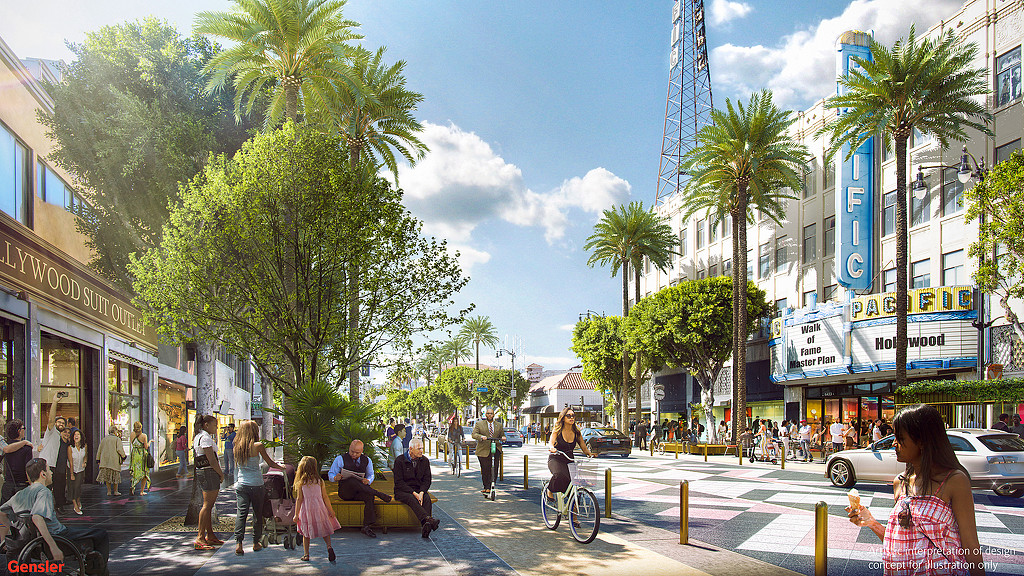Creating Resilient Urbanism With Streetscape Design
April 09, 2021 | By J.T. Theeuwes
Our urban sidewalks are our most extensive, interconnected network of public open space in our cities. Their size and reach give them great potential to become a citywide, resilient ecosystem contributing to our personal wellness and the health of our environment. With relatively low-cost, simple, and time-proven interventions, this expansive network of spaces beneath our feet can provide protection against the effects of climate change.
In most economically and socially vibrant cities, such as Hong Kong, Paris, Barcelona, or the borough of Manhattan, streetscape space comprises about 30 to 35% of a city’s overall land area, while other public open space, such as parks and plazas, (ideally) comprises an additional 15 to 20% of the overall land area. This simple fact of scale imbues our streetscape spaces with potential to be vital agents in the fight against climate change and in creating livable cities.
According to the United Nations, the culprit for 70% of greenhouse gasses (primarily carbon dioxide) comes from our cities — mostly for transportation and for heating and cooling our buildings. We know the climate crisis will intensify as our cities continue to grow, largely due to the great global urban migration happening now. In 2007, for the first time in human history, more people began living in cities than outside them. By 2050, nearly 70% of humanity will live in cities.
The role of well-designed streetscapes in climate resilienceTechnology has played an ever increasing role in helping cities with resilience planning, but before layering our cities with technology to “smarten them up,” we should also remind ourselves of the basic, low-tech strategies that should always be the starting point in preparing our sidewalks to become an urban ecosystem network.
Well-designed streetscapes have the potential to benefit the environment by reducing ambient temperatures, mitigating flooding, replenishing ground water, minimizing light pollution, providing safe habitat for wildlife, reducing our reliance on combustion engine transportation, and cleaning our air and water.
Clean the airIn addition to holding pollution particles on the surface of leaves, trees act as carbon sinks through the photosynthesis process, sequestering carbon, as well as volatile organic compounds (VOC’s) and other air pollutants. One tree can remove 26 pounds of carbon dioxide from the atmosphere annually, the equivalent of 11,000 miles of car emissions.
By adding to the urban tree canopies of our cities, we can increase our ability to reduce air pollution and enhance residents’ health and well-being. And adding street trees along our pedestrian sidewalks is the most productive way our cities can accomplish this. In 1994, trees in New York City removed an estimated 1,821 metric tons of air pollution, at an estimated value to society of $9.5 million.
Cool the cityUrban heat islands are generated when heat-absorptive surfaces such as dark paving and roofing absorb the sun’s energy and radiate it into the environment. Daytime temperatures in urban areas are on average 1 to 6 degrees Fahrenheit higher than in rural areas, while nighttime temperatures can be as much as 22 degrees higher as the heat is gradually released from buildings and pavement.
Trees and vegetation lower air and surface temperatures by providing shade and through evapotranspiration. Air temperatures in summer can be reduced by 2 to 9 degrees. Shaded surfaces, such as building faces, may be 20 to 45 degrees cooler than the peak temperatures of unshaded materials, reducing required cooling loads for such buildings. Street trees close to building façades and windows offer prime opportunities, especially on western faces, to cool down buildings.
Pavements comprise about 40% of and urban space and can alter the climate depending on the proportion of light they reflect, also known as albedo. Higher albedo pavements are lighter and more reflective. By specifying hardscape materials with higher albedo ratings, we can reduce ambient air temperatures by over 2.5 degrees and reduce the frequency of heatwaves by over 40% across all U.S. urban areas. While concrete naturally possess a higher albedo then say, asphalt, its albedo can be further increased by the use of brighter additives such as slag, Portland limestone cement, or reflective aggregates.
Save the waterStorms are increasing in intensity and frequency as global temperatures rise. The average 100 year floodplain is projected to increase 45% by the year 2100 while annual damages from flooding are predicted to increase by $750 million, according to the U.S. Environmental Protection Agency.
Large gray infrastructure investments are common to deal with the issue of stormwater management. Many cities enlarge underground pipes, expand pumping stations, and build new treatment facilities in an ever-escalating race to meet ever increasing stormwater runoff. These kinds of investments cost many U.S. cities in excess of and $1 billion each.
Finding ways of capturing, percolating, and reusing stormwater along our streetscapes and public plazas prevents stormwater from entering these citywide systems and parallels the natural water cycle. Bioswales, rain gardens, cisterns, and permeable surfaces manage stormwater closer to its source and accomplish this in a relatively low-cost manner while treating the water naturally as pollution particulates are absorbed and retained by vegetation and earth through which the water passes.
Mitigating water entering sewer and stormwater systems also reduces pumping costs. By using green infrastructure within their combined sewer area, Lancaster, Pennsylvania, has estimated it will be able to reduce stormwater flows by 700 million gallons, saving $600,000 annually. A similar study by the city of Milwaukee estimates future annual savings of $1.3 million due to reduced pumping and wastewater treatment.
Highlighting the potential impact of green infrastructure, a recent study estimates that by instituting a combination of stormwater capture, water efficiency, and water harvesting programs, California could save 4.5 trillion gallons of water a year — more than is needed to irrigate all of its orchards, nuts, berries, vineyards, and tomatoes, according to the U.S. Environmental Protection Agency.
Protect the habitatThe average abundance of native animal species in most major land-based habitats has fallen by at least 20%, mostly since 1900. We rely on urban wildlife to control pest populations such as rats, ticks, and mosquitos; to carry and disperse seeds; and to pollenate plants. Even scavenger species such as crows, gulls, and magpies perform a valuable “clean up” service protecting streets from the spread of disease. This urban wildlife needs food, water, shelter, and space. A lack of shelter and space leads to overcrowding of species, leading to competition for resources and limiting the number of animals that can productively inhabit an area.
Providing shelter and importantly, habitat connectivity, helps animals move around territories, find mates, hunt, forage, and reproduce. Our city streets, once major contributors to habitat fragmentation, can now be used to interconnect urban animal habitats of parks and plazas with each other via our landscaping and street trees, forming natural corridors between patches of significant natural areas.
Increase mobilityIn addition to heating and cooling our buildings, greenhouse gasses also stem largely from transportation — particularly the single occupancy vehicle. Taking the bus will cut your carbon footprint by half, according to some estimates. Busses last longer than cars and can carry more people, which means that producing them accounts for less emissions per passenger and less embodied energy related to vehicle production and transport to market. And biking CO2 emissions total 10 times less than a car over the same distance.
Adding alternate mobility options along our streetscapes, such as public transportation lanes, protected bike and scooter lanes, and pleasant, interesting, and safe spaces to walk allow people to move within a city while minimizing their carbon footprint.
In many city budgets, public plazas, parks, and streetscapes are considered less of a priority than other municipal services. This frequently shortchanges our streetscapes, which should be seen as an essential part of a city’s success. Our city streets and sidewalks have the potential to not only enhance the lives of the people who inhabit them, but also to help our cities become more environmentally resilient. By combining the size and reach of our city street and sidewalk space with some simple and time-tested strategies, we can greatly increase our ability to create more livable cities.
For media inquiries, email .

